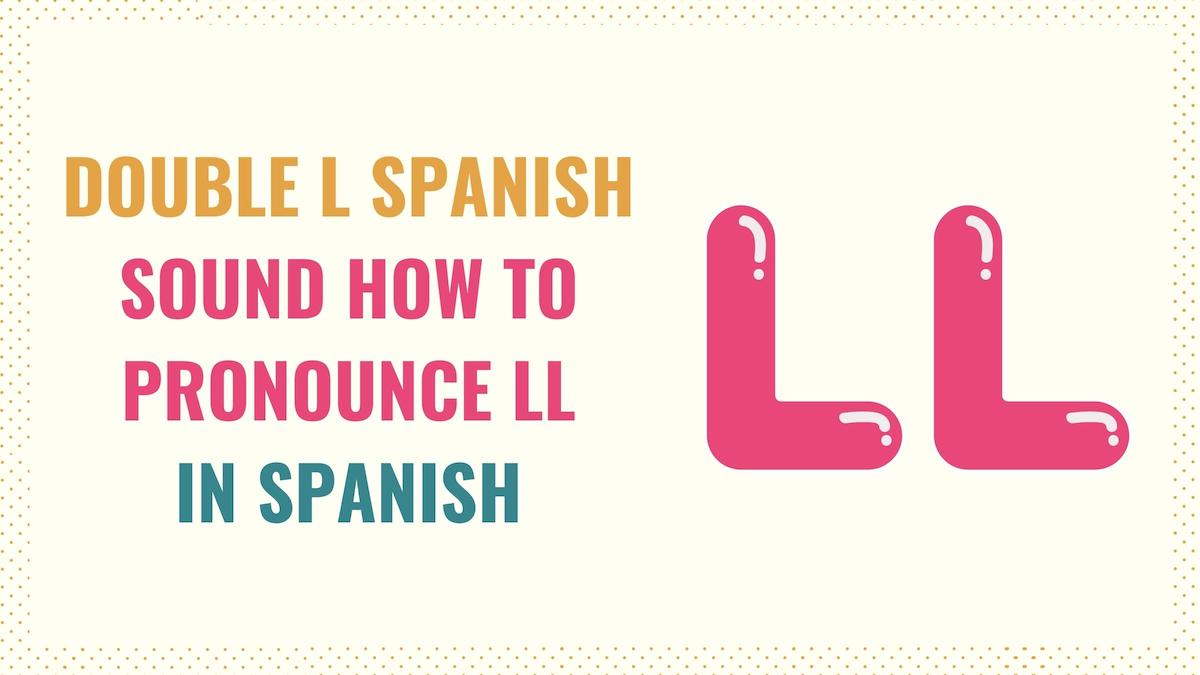The Spanish double ll sound is used in many basic verbs and words. As a result, mastering its pronunciation is key to your speaking skills. Since the double l has a different sound in English, many wonder how to pronounce ll in Spanish. So, in this guide, you’ll find:
I’ve included recordings with the ll sound to make this guide as practical and comprehensive as possible.
How to Pronounce LL in Spanish
The double l in Spanish, also known as ‘elle’, sounds like the Spanish y sound. For the most part, the ll pronunciation is close to the English ‘j’, and sometimes ‘y’ sounds.
Here is how the Spanish vowels sound when working with the double ll (lla, lle, lli, llo, llu):
Now that you’ve identified these sounds check these words with ll in Spanish:
| Spanish word | Sounds like |
|---|---|
| Llamar (call) | Jam |
| Ella (she/her) | Janet |
| Ballena (whale) | Yellow |
| Pollo (chicken) | Job |
| Lluvia (rain) | Yusef |
Like the ‘CH’, the double l is not in the Spanish alphabet because it’s not considered a letter but a digraph (two letters making one sound). Despite this, the ‘ll’ is a key sound used in many basic words.
In the previous examples, you learned the most standard way to pronounce ll in Spanish. In other words, this is the pronunciation you’ll use in Spain, Mexico, and most Spanish-speaking countries. However, some dialects have slightly different pronunciations, as you are about to see.
Take Note: In Spanish, the ll is close in sound to the English ‘y’ and ‘j’. However, keep in mind that the way English vowels are pronounced is different than in Spanish, which impacts the pronunciation.
Double ll sound variations
One of the most outstanding features of Rioplatense Spanish, the Spanish spoken in Argentina and Uruguay, is its pronunciation. One sound that stands out is the double l (ll) pronunciation, which differs from other Spanish variants.
In this dialect, the Spanish ll sounds like a ‘sh’:
- Llave: Shave
- Llegar: Shegar
- Cabello: Cabesho
- Lluvioso: Shuvioso
In some parts of Central America, the ll sound is weaker than the standardized ‘y’ sound. Simply put, in some of these countries, the double l sounds like if you were to combine the Spanish ‘i’ sound with another vowel (similar to the pronunciation of the English name Mia).
Here are some examples:
- Llama: Iama
- Calle: Caie
- Pollo: Poio
As established before, the most common way to pronounce ll in Spanish is with the ‘y’ sound. So, you only have to learn these pronunciation variations if you’re focusing on these Spanish dialects.
Take Note: Despite the differences in pronunciation, Spanish speakers are able to understand each other.
Spanish Words that Start with LL
Here are some Spanish words that start with ‘ll’. Use this list as a way to practice pronunciation:
Verbs:
Nouns & Adjectives:
- Llama: Flame / Lama
- Llamada: Call
- Llanta: Tire
- Llave: Key
- Lleno: Full
- Llorón: Weepy
- Lluvia: Rain
Spanish words containing ll:
- Allá: There
- Ballena: Whale
- Bello: Beautiful
- Brillante: Shiny
- Caballo: Horse
- Cabello: Hair
- Calle: Street
- Cebolla: Onion
- Cuello: Neck
- Ella: She / Her
- Falla: Fault
- Gallina: Hen
- Gallo: Rooster
- Grillo: Cricket
- Pastilla: Pill
- Pollo: Chicken
- Rodilla: Knee
- Silla: Chair
- Sillón: Armchair
Key Points
In Spanish, the double ll sound is crucial to pronounce basic verbs and common words correctly. Here are some key points you should know:
- The double l is also called elle.
- Ll is not a letter in the alphabet because it’s a digraph.
- The double ll sounds exactly like the letter y in Spanish. This is called yeísmo, and it’s the most standard way to pronounce this sound.
- The Spanish ll sounds close to the English letters ‘j’ and ‘y’.
- In Argentina and Uruguay, the double l has a sh sound (like sharp, Shonda, shed).
Spanish Pronunciation Resources
Having good pronunciation can help you sound more natural and clear when speaking Spanish. Check the Spanish alphabet to see this language’s different consonant and vocalic sounds.
Also, repeating some tongue twisters is helpful to practice difficult sounds. Here is a tongue twister you can use to practice the ‘ll’ sound:
Necesito un tornillo destornillar,
quien tendrá un destornillador
que me ayude
a este tornillo destornillar.
Download the Double L Spanish Sound PDF
Finally, feel free to download a copy of the PDF for this guide. In it, you’ll find the key examples, graphics and key points on how to pronounce ll in Spanish with precision and confidence.



